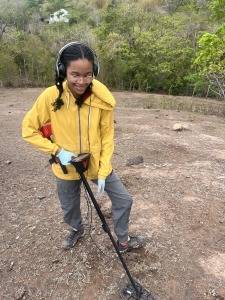By Ariel Gilmore
 This summer, I got to travel to Providencia, Colombia with USC professor Tracie Mayfield. The work of my team is a project of discovery and justice. Archaeology recovers the lost, tangible remains of a continuous history of island life for the native Raizal people who live there today. This field school gives this Indigenous group information about their past. Islanders here speak English–brought by Puritans and pirates starting 400 years ago–and also Spanish, the language of the conquistadors and the present-day Republic of Colombia, which claims the island.
This summer, I got to travel to Providencia, Colombia with USC professor Tracie Mayfield. The work of my team is a project of discovery and justice. Archaeology recovers the lost, tangible remains of a continuous history of island life for the native Raizal people who live there today. This field school gives this Indigenous group information about their past. Islanders here speak English–brought by Puritans and pirates starting 400 years ago–and also Spanish, the language of the conquistadors and the present-day Republic of Colombia, which claims the island.
I worked shoulder to shoulder with island residents, faculty from US universities, and students from six different states. My favorite days were spent discovering material traces of enslaved people who had fled to freedom on the island – they lived in hidden maroon camps – and sites that still produce traces – but not treasure – from the days when pirates were privateering on this remote island.
Equally exciting was the time spent interviewing and getting to know members of the local community whose culture we encountered in the local Creole language, foods, traditions, names, and hopes for the future. My typical fieldwork day started with a home-cooked breakfast made by Enilda, the owner of the posada–or inn–that we called home. We rode to field sites in open-air vehicles called “mules” on this island, which means souped-up golf carts with off-road tires. Daily, I gazed out over the seven brilliant hues of Caribbean blue and green on my way to work, truly a view you can’t get anywhere else. After about five hours of work, our second home-cooked meal of the day was followed by a lab session that expanded my archaeology skills exponentially. I can identify ancient pottery and china, glass bottles for medicine and liquor, and I’m a capable artifact photographer ready to contribute to other research projects. Each precious find tells part of a story of life on this Caribbean island, then and now, because the past is making possibilities for people today, in the present.
 Another connection to the local community members occurred after lab work when we got to hear talks and stories of islanders’ childhoods, traditional ecological knowledge, and indigenous science, which they call “Bush Medicine”. Providencia Island is the only place you can learn about this! Free time allowed me opportunities to sample street food with people I met or to catch a live music performance on the beach.
Another connection to the local community members occurred after lab work when we got to hear talks and stories of islanders’ childhoods, traditional ecological knowledge, and indigenous science, which they call “Bush Medicine”. Providencia Island is the only place you can learn about this! Free time allowed me opportunities to sample street food with people I met or to catch a live music performance on the beach.
Every part of the research in this field school emphasized community engagement, including our archaeological work. This enriched my overall experience because I came to understand that artifacts connect in visceral, tangible ways to people and their lived experiences, then and now. Archaeology came alive to me as an interdisciplinary field that enhances people’s sense of belonging and identity, so things are never just things, rather they are pieces of the community that still lives on this island, a living thriving and real connection to the global flows of dreams achieved and dashed, of enslavement, of nations that powered their way through communities and cultures to create trade which made and lost fortunes, which transformed governance, and left us the world we live in today.
Ariel Gilmore is a 2024 Vera Campbell Scholarship recipient who attended IFR’s Providence Island Excavation & Ethnography Program.

